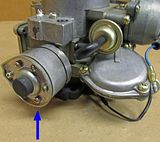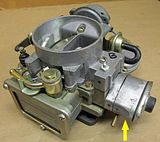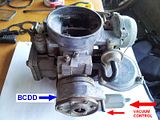Boost Controlled Deceleration Device (B.C.D.D) serves to reduce HC emission emitted from the engine during coasting. It is used by some Datsuns, but not by Datsun 1200.
Contents |
Overview
BCDD starting June 1971 for Datsun 510 USA


Hose fitting by yellow arrow goes to air cleaner
B.C.D.D. with Vacuum Control Solenoid Valve (e.g. 1974 Datsun 620 USA with L18 engine)

Boost controlled deceleration device (B.C.D.D) serves to reduce HC emission emitted from the engine during coasting.
The high manifold vacuum during coasting prevents the mixture from complete combustion because of the reduced amount of mixture per cylinder per rotation of engine, with a result that large amount of HC emission is emitted into the atmosphere.
B.C.D.D. has been designed based on the idea of eliminatin this objection. It operates in such a way that, when manifold vacuum exceeds a predetermined value, it provides and additional mixture of optimum mixture ratio and quantity iinto the manifold by opening the separate mixture passage in the carburetor. Complete combustion of fuel is assisted by this additional mixture, and remarkably reduces the amount of HC contained in exhaust gases.
During the period from coasting to idling, the transmission produces a signal which in turn energizes the vacuum control solenoid. As this takes place, the valve is lifted off its seat, releasing the vacuum chamber to the atmosphere. The mixture control valve will then be close, returning engine speed to the predetermined idling.
Vacuum Control Solenoid Valve
Hitachi DCH340 models with BCDD Control Solenoid, which apparently de-activates BCDD operation.
MANUAL TRANSMISSION: The solenoid is electrically operated according to Speedometer Switch and amp, and a relay box. At speeds below 10mph the valve is operated.
AUTOMATIC TRANSMISSION: The solenoid is electrically operated according to the Nuetral Safety Switch. When in Nuetral or Park, the valve is operated.
Adjustment
Adjustment requires:
- Tachometer
- Precision vacuum gauge
Pull the black rubber cover off the center of the BCDD to expose the adjustment screw.
To properly set the BCCD operating pressure, proceed as follows:
0. Run engine until fully warm. Check and adjust if necessary:
Timing Idle speed Idle mixture
1. Run the engine under no load [in neutral]. Increase engine rpm to 3,000 to 3,500 rpm, then quickly close throttle valve. At this time, the manifold vacuum pressure increase abruptly to -23.62 inHg or above and then gradually decreases to the level set at idling.
2. Check the the BCDD operating pressure is within the specified range.
BCDD set pressure:
-19.69 inHG manual transmission
-18.90 inHg automatic transmission
3. If it is higher than the set level, turn the adjusting screw counterclockwise
4. Race the engine and check again
5. If it is lower than the set level, turn clockwise
6. Race the engine and check again
WHEN THE OPERATING PRESSURE IS extremely LOW, idle speed is not restored. Adjust as indicated above.
Others
Not to be confused with "Coasting Air Solenoid Valve" (triangle base on Hitachi DAF328)

Not to be confused with Fuel-Cut Valve or Anti-diesel Valve:


![[Datsun 1200 encyclopedia]](/wiki/upload/wiki.png)